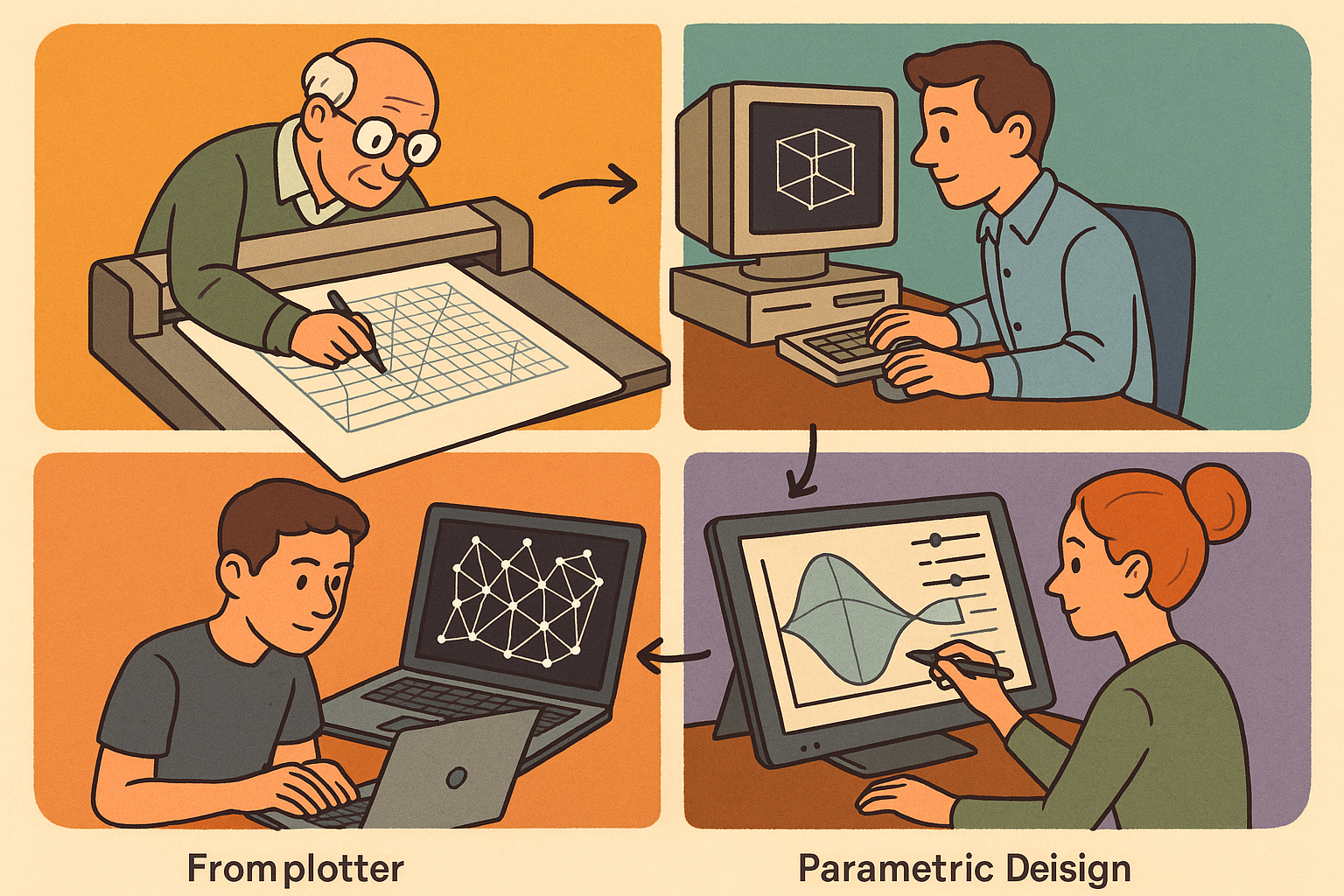Your Cart is Empty
Customer Testimonials
-
"Great customer service. The folks at Novedge were super helpful in navigating a somewhat complicated order including software upgrades and serial numbers in various stages of inactivity. They were friendly and helpful throughout the process.."
Ruben Ruckmark
"Quick & very helpful. We have been using Novedge for years and are very happy with their quick service when we need to make a purchase and excellent support resolving any issues."
Will Woodson
"Scott is the best. He reminds me about subscriptions dates, guides me in the correct direction for updates. He always responds promptly to me. He is literally the reason I continue to work with Novedge and will do so in the future."
Edward Mchugh
"Calvin Lok is “the man”. After my purchase of Sketchup 2021, he called me and provided step-by-step instructions to ease me through difficulties I was having with the setup of my new software."
Mike Borzage
Optimizing Product Design: The Role of Design for Manufacturability (DFM) in Modern Engineering
September 28, 2024 6 min read


In today's competitive market, creating products that are not only innovative but also efficient to produce is essential. This brings us to the concept of Design for Manufacturability (DFM), a critical approach in modern product development that ensures designs are optimized for ease of manufacturing, cost reduction, and quality enhancement.
Introduction to Design for Manufacturability (DFM)
Design for Manufacturability (DFM) is a systematic approach that integrates product design and process planning into one common activity. The goal is to design products in such a way that they are easy to manufacture, assemble, and test, leading to significant improvements in production efficiency and product quality. By considering manufacturing constraints during the design phase, engineers can identify potential issues early on and make informed decisions that positively impact the entire production lifecycle.
Implementing DFM principles means that designers proactively address factors such as material selection, part geometry, tolerances, and assembly methods. This proactive approach can lead to substantial cost savings by reducing the need for complex manufacturing processes, minimizing material waste, and decreasing the likelihood of production errors. Moreover, products designed with manufacturability in mind often exhibit higher quality because they are less prone to defects and inconsistencies.
The integration of advanced tools into the DFM process has revolutionized how designers and engineers collaborate. Modern Computer-Aided Design (CAD) software and simulation tools provide real-time feedback on design choices, highlighting potential manufacturing challenges before they become costly problems. This seamless integration of tools not only enhances the efficiency of the design process but also ensures that the final product is optimized for production from the outset.
Key Principles of Design for Manufacturability
The foundation of effective DFM lies in adhering to several key principles that guide designers toward creating products that are both functional and manufacturable. Understanding and applying these principles can lead to significant improvements in production efficiency and product quality.
Simplicity is paramount in design. By minimizing complexity in parts and assemblies, manufacturers can reduce production time, lower costs, and decrease the potential for errors. Simple designs are easier to produce, assemble, and maintain. They often require fewer specialized tools and less skilled labor, which can be especially beneficial when scaling up production.
Standardization involves using common components and materials across products and assemblies. This practice reduces inventory requirements, simplifies procurement, and enhances compatibility between different product lines. Standard parts are typically easier to source and replace, which can lead to faster production times and reduced costs. Moreover, standardization can streamline the training process for assembly workers, as they become familiar with a consistent set of components.
Tolerance Management is critical for ensuring that parts fit together correctly and function as intended. Effective tolerance control leads to easier manufacturing and assembly by specifying acceptable variations in part dimensions. Tight tolerances can increase manufacturing costs and complexity, so it's important to balance precision with practicality. Utilizing statistical analysis and understanding the capabilities of manufacturing processes can help designers set appropriate tolerances that ensure quality without unnecessary expense.
Material Selection plays a significant role in manufacturability and cost-effectiveness. Designers must consider factors such as material properties, availability, cost, and compatibility with manufacturing processes. Selecting the right material can improve product performance while also simplifying manufacturing. For instance, choosing a material that allows for simpler fabrication methods or requires less finishing work can lead to substantial cost savings.
By focusing on these key principles, designers can create products that are optimized for the entire production process. This holistic approach not only benefits manufacturers by reducing costs and improving efficiency but also leads to higher-quality products that meet customer expectations.
Integrated Tools for DFM Optimization
Advancements in technology have provided designers and engineers with powerful tools to optimize designs for manufacturability. These integrated tools facilitate collaboration, provide real-time feedback, and enhance the ability to predict and resolve potential manufacturing issues during the design phase.
CAD Software Features have evolved significantly, offering a range of functionalities that support DFM. Modern CAD software includes simulation and analysis features that allow designers to test how their products will perform under real-world conditions. These tools can simulate stress analysis, thermal dynamics, and fluid flow, among other parameters. By identifying potential issues early, designers can make adjustments before production begins, saving time and resources.
In addition to simulation capabilities, many CAD programs offer automated checks for manufacturability. These checks can analyze designs for features that may be difficult or expensive to produce, such as undercuts or sharp internal corners. By highlighting these areas, the software enables designers to modify their designs for easier manufacturing.
Collaboration Platforms are essential in promoting communication between design and manufacturing teams. Integrated platforms allow for seamless sharing of design files, feedback, and updates in real-time. This level of collaboration ensures that all stakeholders are aligned throughout the development process. Effective communication helps to identify potential challenges early and fosters a cohesive approach to problem-solving.
Features of collaborative platforms often include version control, which tracks changes made to designs, and comments or annotation tools that allow team members to provide input directly on the design. This integrated approach reduces the risk of miscommunication and ensures that manufacturing considerations are incorporated into the design from the outset.
Automated Feedback Tools provide real-time insights into how design choices affect manufacturability. These tools can perform dimensional checks, analyze assembly sequences, and even suggest alternative design solutions. By utilizing automated feedback, designers receive immediate guidance on potential issues, enabling them to make informed decisions quickly.
- Real-time dimensional analysis checks for potential assembly interference and misalignments.
- Assembly simulations visualize how components fit and work together, identifying potential assembly challenges.
Such tools often integrate machine learning algorithms that learn from past designs and manufacturing data to provide increasingly accurate and helpful suggestions. This integration of intelligent feedback mechanisms streamlines the design process and enhances the final product's manufacturability.
The use of integrated tools in DFM not only improves the efficiency of the design process but also significantly reduces the risk of costly manufacturing errors. By leveraging these technologies, companies can produce higher-quality products more efficiently, maintaining a competitive edge in the marketplace.
Practical Applications and Future Trends
The principles and tools of Design for Manufacturability are applied across various industries to improve production processes and product quality. Incorporating DFM into the design process leads to products that are easier to manufacture, assemble, and bring to market, ultimately enhancing customer satisfaction and company profitability.
In practical applications, companies that embrace DFM principles often experience reduced production costs due to streamlined manufacturing processes and minimized waste. By designing products with manufacturability in mind, they can avoid costly redesigns and delays associated with production issues. This not only saves money but also accelerates time-to-market, giving companies a competitive advantage.
Moreover, products designed for manufacturability tend to have improved product quality. Simplified designs with standardized components are less prone to errors and defects, leading to higher customer satisfaction and fewer returns or warranty claims. Enhanced quality can also strengthen a brand's reputation, fostering customer loyalty and repeat business.
Looking ahead, future trends in DFM tools and practices are poised to further revolutionize the design and manufacturing landscape. One significant development is the integration of Artificial Intelligence (AI) and Machine Learning into design tools. AI-driven assessments can analyze vast amounts of data from previous designs and manufacturing processes to provide intelligent recommendations. These systems can suggest design modifications to enhance manufacturability, predict potential issues, and optimize material usage.
Another emerging trend is the use of Additive Manufacturing, or 3D printing, which allows for greater design flexibility and the ability to produce complex geometries that were previously difficult or impossible to manufacture. Integrating DFM principles with additive manufacturing techniques can lead to innovative products that take full advantage of these new capabilities while still being efficient to produce.
- AI-driven tools that provide predictive analytics for manufacturing outcomes.
- Expanded use of virtual and augmented reality for design visualization and collaboration.
Furthermore, advancements in Collaboration Technologies are enabling even more seamless communication between multidisciplinary teams. Enhanced virtual collaboration platforms allow for real-time interaction among designers, engineers, and manufacturers, regardless of their physical locations. This global collaboration can lead to more innovative solutions and a more efficient design process.
In summary, the practical application of DFM principles, supported by integrated tools and emerging technologies, continues to drive significant improvements in manufacturing efficiency and product quality. As the industry evolves, organizations that stay abreast of these trends and incorporate them into their processes will be well-positioned to succeed in an increasingly competitive market.
Also in Design News

Design Software History: From Plotters to Procedural Intent: A Technical History of Generative and Parametric Design Software
January 04, 2026 13 min read
Read More
Semantic Meshes: Enabling Analytics-Ready Geometry for Digital Twins
January 04, 2026 12 min read
Read MoreSubscribe
Sign up to get the latest on sales, new releases and more …



